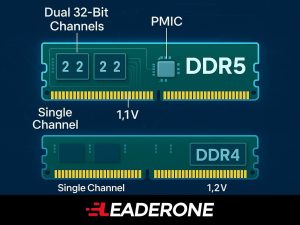
Visual comparison of DDR5 and DDR4 modules showing architecture and power management differences.
The world of computing relies heavily on memory. RAM, or Random Access Memory, is crucial for system performance. For years, DDR4 has been the standard. Now, DDR5 memory is taking over. Understanding the DDR5 vs DDR4 differences is key for anyone building or upgrading a PC. DDR5 brings significant improvements across speed, efficiency, and architecture.
This new generation of RAM is not just faster. It’s built for the demands of modern processors. These include multi-core CPUs and AI workloads.
Key Technical Differences
DDR5 represents a major architectural overhaul compared to DDR4. Here’s a breakdown of the core distinctions:
- Speed and Bandwidth:
- Operating Voltage:
- DDR4: Operates at 1.2V.
- DDR5: Operates at a lower 1.1V. This reduction contributes to better power efficiency. It also generates less heat, despite higher frequencies.
- Power Management:
- DDR4: Power management is handled by the motherboard.
- DDR5: Features an on-DIMM Power Management IC (PMIC). This moves voltage regulation to the module itself. This improves power delivery control. It also enhances signal integrity and reduces noise.
- Channels Per DIMM:
- DDR4: Has one 64-bit data channel per memory module (DIMM).
- DDR5: Divides each DIMM into two independent 32-bit channels (plus 8 bits for ECC per sub-channel). This increases channel efficiency and concurrency.
- On-Die ECC (Error-Correcting Code):
- DDR4: Lacks internal ECC.
- DDR5: Incorporates on-die ECC. This detects and corrects errors within the DRAM chips themselves. This boosts reliability and stability, especially at higher speeds and densities. (Note: This is not full system-level ECC like on server-grade RAM).
- Module Capacity:
- DDR4: Maximum die density was 16 Gigabit (Gb) per die.
- DDR5: Supports up to 64 Gb per die. This allows for much higher capacity modules. Think 256GB per single stick for future applications.
Performance and Practical Implications
The DDR5 vs DDR4 differences translate into real-world benefits:
- Gaming: While initial DDR5 might show mixed results in some games due to higher latencies, its overall higher bandwidth generally leads to better minimum frame rates and smoother performance, especially at higher resolutions or with high-end GPUs.
- Content Creation: Tasks like video editing, 3D rendering, and large file compression benefit greatly from DDR5’s increased bandwidth. Faster data access means quicker processing.
- AI and Machine Learning: These workloads demand massive data throughput. DDR5’s increased speed is critical for feeding data to GPUs and specialized AI accelerators.
- Power Efficiency: The lower voltage of DDR5 makes it more energy-efficient. This is particularly beneficial for laptops and data centers, reducing power consumption and heat.
- Cost and Compatibility: DDR5 was initially more expensive. Prices have dropped, making it more competitive. However, DDR5 requires new motherboards and CPUs (e.g., Intel 12th Gen+ or AMD AM5+ platforms). It is not backward compatible.
In summary, DDR5 represents a significant step forward in memory technology. It offers superior speed, efficiency, and architectural enhancements. As new platforms become standard, DDR5 will continue to drive performance gains across all computing applications.
